Contributory members are able to log private notes and comments about each site
Sites Anne T has logged. View this log as a table or view the most recent logs from everyone
St Mary's Church (Gilcrux)
Trip No.91 Entry No.2 Date Added: 16th Aug 2018
Site Type: Ancient Cross
Country: England (Cumbria)
Visited: Yes on 14th Aug 2018. My rating: Condition 3 Ambience 4 Access 5

St Mary's Church (Gilcrux) submitted by Anne T on 10th Jul 2018. We may not have been able to see the Viking cross head and shaft fragment, but we did spot this underneath the window in the southern external wall of the sanctuary. The notes inside the church say it is the remains of a grave slab, recut for use as a lintel.
(View photo, vote or add a comment)
Log Text: St Mary's Church, Gilcrux: The little car park outside the church was full (3 cars and a Water Board van), so we had to park just west of the well and walk back to the church – only a little way. The church door was open for us this time.
This is a remarkable little church inside. At first site, the nave appears more like a Methodist chapel – at first glance. Then my gaze lit on the archway into the chancel, with a ‘squint’ over the right hand column and a chunk taken out of the eastern side of the left hand column. Walking into the chancel is very reminiscent of Escombe Saxon Church – this place is ancient and very peaceful.
The collection of stones was underneath a table against the south wall, near the porch, so we turned into furniture removers, carefully taking the notice board, vases and loose notices off the table, then moving the table to examine and photograph the pieces.
We managed to put together the pieces of the cross head and part of the shaft, and photographed two sides. One of the pieces left white, chalky marks on our hands, and is very white against the grey of the other two pieces. This is clearly the cast of the upper part of the cross head.
We closed the church door to indicate to the keyholder we’d been in and left again, and walked round to the north side of the church, where it is very obvious that the church has been built on a mound.
There was no church guide book, but there were some ‘notes for visitors’ which I photographed, and have typed into my walk journal.
The spring was in full flow, and it was lovely to hear it babbling away. Brilliant. Definitely worth a return visit.
St John The Evangelist (Crosscanonby)
Trip No.91 Entry No.3 Date Added: 17th Aug 2018
Site Type: Ancient Cross
Country: England (Cumbria)
Visited: Yes on 14th Aug 2018. My rating: Condition 3 Ambience 4 Access 5
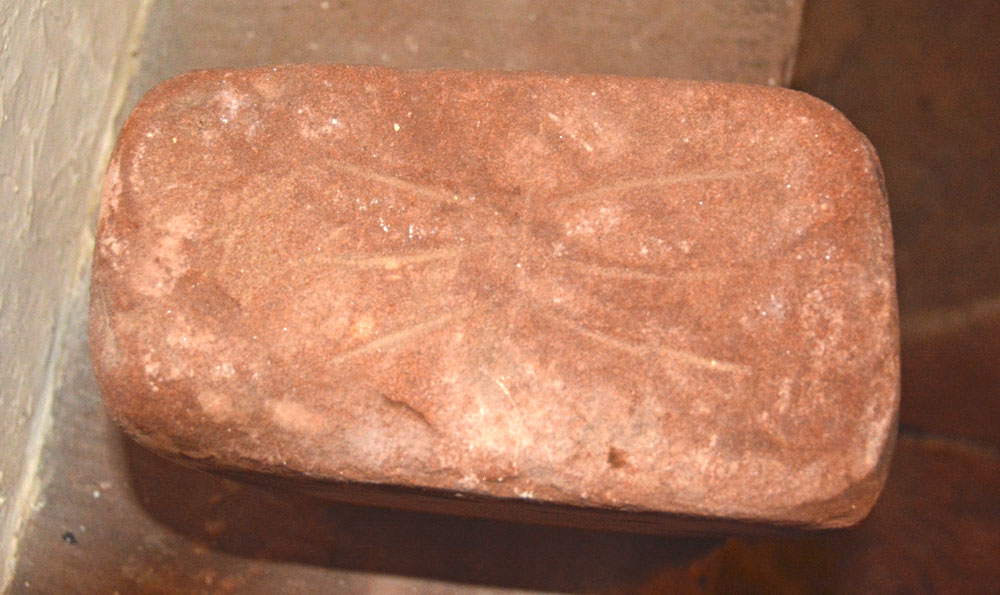
St John The Evangelist (Crosscanonby) submitted by Anne T on 17th Aug 2018. Face D of AS Corpus Cross Canonby 03, also known as The Thunder Bolt Stone. The Corpus tells us this face shows: "the incised ornament consisting of a single horizontal line on which converge three incised lines from above and below." This is the famous 'thunder bolt' symbol.
(View photo, vote or add a comment)
Log Text: St John The Evangelist, Crosscanonby: We had arranged to meet the Reverend Mary at the church at 2pm. Between Gilcrux and here we had an hour to spare, so went into Cockermouth for lunch and a quick walk round the town. Travelling through Dearham and across the A596 to Crosscanonby, as we dropped down a small hill after having crossed the A596, we realised how close this church is to the Solway Firth (according to UK Grid Finder measurements its 900m).
This little church is side on to the road, and is virtually invisible until you reach the gate into the churchyard, although the ‘this church is open’ board gave something away.
I’d not looked at the AS Corpus notes I’d brought, but straight away we spotted the hogback against the south eastern corner of the nave.
Walking inside was a real treat. This is clearly a very old building. Reverend Mary (just ‘Mary’ she said) told us this church used to be the mother church for Maryport and the farm house next door (to the west of the church) used to be part of the monastery; the monks used to process from the monastery to the church; rumour has it there is a tunnel from the farmhouse to the church, but it’s never been found.
The church is pretty special, although I focussed on photographing the stones in the porch whilst Andrew spoke to Mary about the structure of the building, as I was conscious of taking up Mary’s time and we needed her to come across to Dearham to open the vestry for us. I’d love to go back and spend more time here.
St Mungo's Dearham
Trip No.91 Entry No.4 Date Added: 16th Aug 2018
Site Type: Ancient Cross
Country: England (Cumbria)
Visited: Yes on 14th Aug 2018. My rating: Condition 3 Ambience 4 Access 5
St Mungo's Dearham submitted by coin on 29th Mar 2017. The Viking Cross at Dearham
(View photo, vote or add a comment)
Log Text: St Mungo's Church, Dearham: AS Corpus Dearham 03 and The Adam Stone: This was a return visit. pre-arranged with the lovely Reverend Mary, who drove from Crosscanonby to very kindly unlock the door of the vestry to show us AS Corpus Dearham 03, part of a cross-head.
We also saw the Adam Stone. Mary moved the knitted figures of Jesus and Peter and invited me to climb on the pew to get a better photograph. We felt so welcome, we didn’t really want to leave!
St Bridget's Church (Bridekirk)
Trip No.91 Entry No.5 Date Added: 18th Aug 2018
Site Type: Ancient Cross
Country: England (Cumbria)
Visited: Yes on 14th Aug 2018. My rating: Condition 3 Ambience 4 Access 5
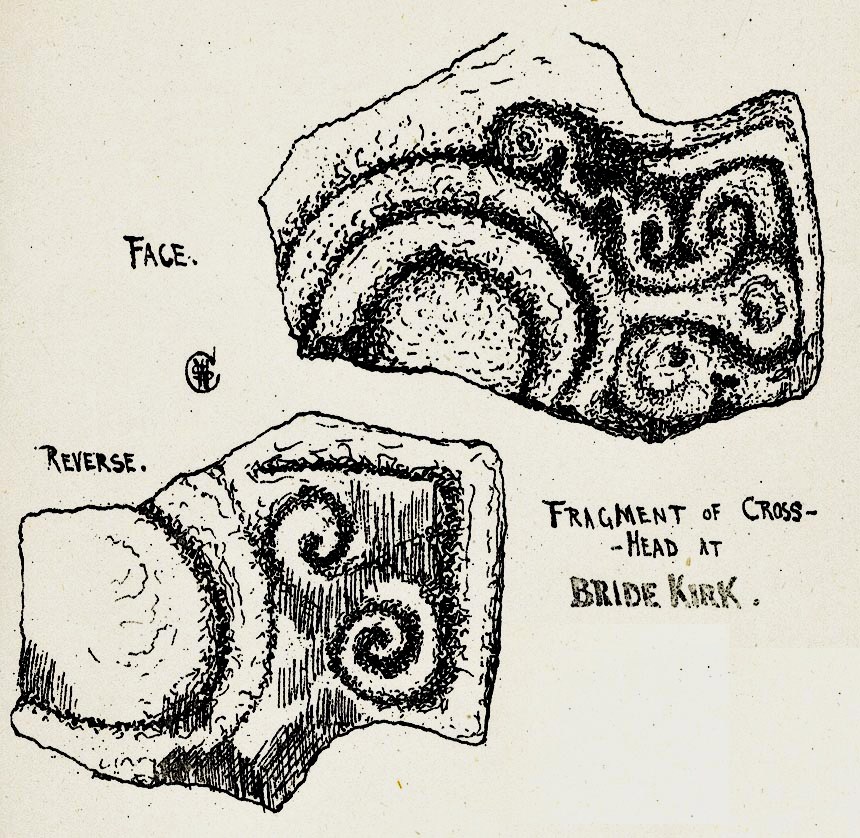
St Bridget's Church (Bridekirk) submitted by Sunny100 on 19th Apr 2011. Illustration of The Cross-Head fragment at St Bridget's Church, Bridekirk, Cumbria, by Rev William Slater Calverley 1847-98.
The above image is from his renowned work 'Early Sculptured Crosses, Shrines and Monuments in the Present Diocese of Carlisle 1899 Ed. by W.G. Collingwood.
(View photo, vote or add a comment)
Log Text: Font with Runic inscription, St. Bridget's, Bridekirk: We had an hour to fill between appointments between churches, so headed off to Bridekirk to see the font with runic inscription, which we'd missed during our last visit on 1st May 2015. The notice said the church was "normally open during daylight hours" but on this occasion the main door appeared to be bolted at the top from the inside, so we couldn't get in. This time, not having a six month old granddaughter with us, we walked round the outside of the church and noticed a collection of old grave slabs displayed against the exterior of the apse at the east end of the church, including an old cross base. None of these in mentioned on Pastscape.
Checking back in my photos, I had taken a photograph of the font. The middle band (when enlarged) does indeed have a runic inscription on it.
Chantry Well (Brigham)
Trip No.91 Entry No.6 Date Added: 18th Aug 2018
Site Type: Holy Well or Sacred Spring
Country: England (Cumbria)
Visited: Yes on 14th Aug 2018. My rating: Condition -1 Ambience 2
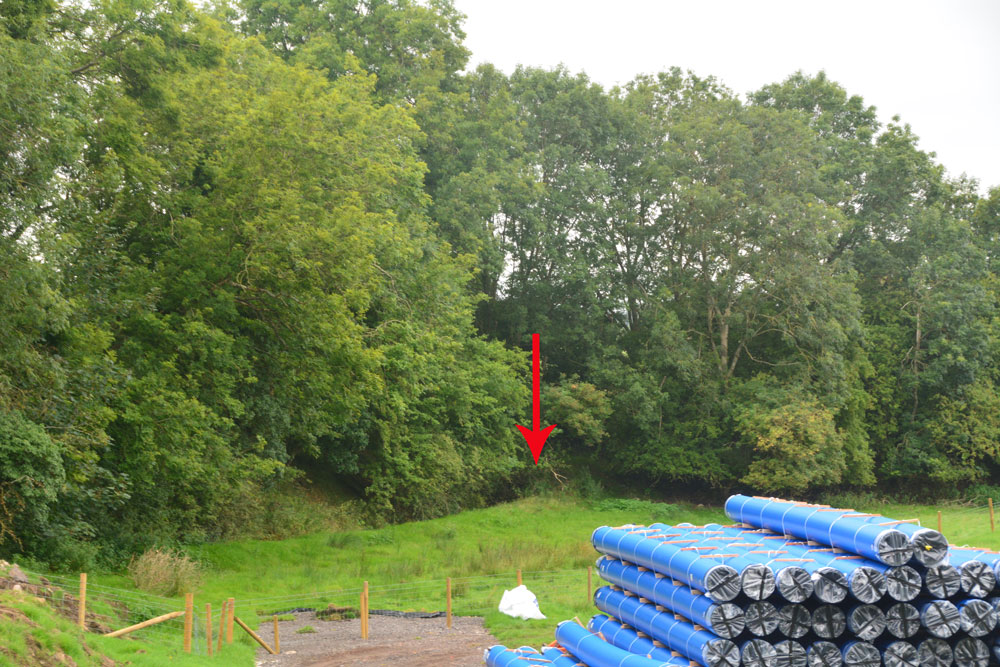
Chantry Well (Brigham) submitted by Anne T on 16th Aug 2018. This is the approximate site of the Chantry Well, as pointed out by the church warden of St. Bridgets, and as recorded by Pastscape Monument 9025 and the Old Cumbria Gazetteer. A new mains water pipeline is being driven through the field, although it was previously recorded the well was destroyed by quarrying. Some marshy ground still remains fenced off in the corner by the red arrow.
(View photo, vote or add a comment)
Log Text: Chantry Well, Brigham (Destroyed) The Reverend Mary told us there was a holy well at Brigham. There are actually 2 listed – Chantry Well and Nun’s Well, next to the A66.
Mr. Furness, the church warden also mentioned the well, but said it was no longer there. In the field opposite the church, a new water pipeline is being constructed. In the field to the south a new housing estate is also being built. There is no access into the field because of the building works, but the grid reference gives a point where the tree line bends.
St Bridget's Church (Brigham)
Trip No.91 Entry No.7 Date Added: 18th Aug 2018
Site Type: Ancient Cross
Country: England (Cumbria)
Visited: Yes on 14th Aug 2018. My rating: Condition 3 Ambience 4 Access 5
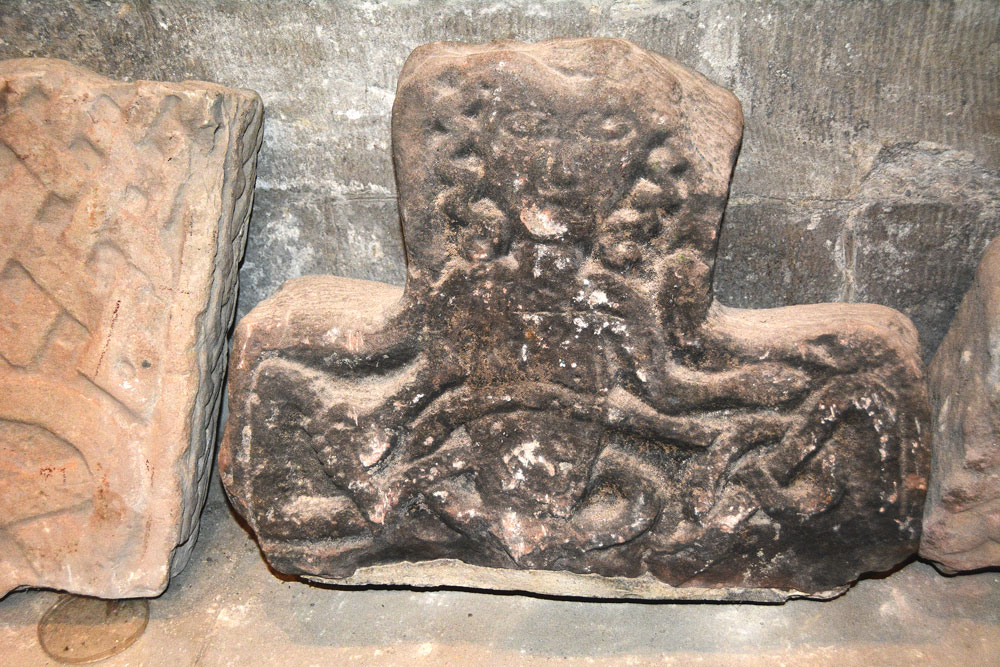
St Bridget's Church (Brigham) submitted by Anne T on 18th Aug 2018. This is Brigham 05, part of a cross-head dating to the 10th century. It was first recorded in 1881, presumed to have been found in restorations of 1864 or 1875-6. Note the curly haired naked figure, with his right hand and a snake (or interlace) bound across his stomach. His left hand is described as having an open palm, lying above the interlace of the right arm.
(View photo, vote or add a comment)
Log Text: St Bridget's, Brigham (Anglo Saxon Stones): Whilst this church looks very austere from outside, and the entrance doors dark and foreboding, once inside the church, it is a completely different picture – this church is light, airy and welcoming. The painted ceilings are fantastic.
The church warden turned up as arranged, and was so welcoming. He sought out a guide to the church and old postcards for information, then left me photographing the stones whilst Andrew walked round the church with him.
Time was all too short here, and I could have spent another hour, but we knew the church warden needed to get home, and the evening traffic was building up outside. In our haste, we missed Brigham 13, a cross base at the west end of the church (I thought I’d photographed it, as we went through all the AS Corpus pages I’d brought with me, but realised (too late) it wasn’t the correct stone).
After looking at the Fletcher family grave (now very worn and held together with large staples, I walked over to the west end of the churchyard to look at the farmhouse, which used to be the rectory for the farm).
We also looked for the site of Nun's Well, but were unable to see anything.
St Mungo's Well (Cumbria)
Trip No.91 Entry No.8 Date Added: 18th Aug 2018
Site Type: Holy Well or Sacred Spring
Country: England (Cumbria)
Visited: Yes on 14th Aug 2018. My rating: Condition 3 Ambience 4 Access 4
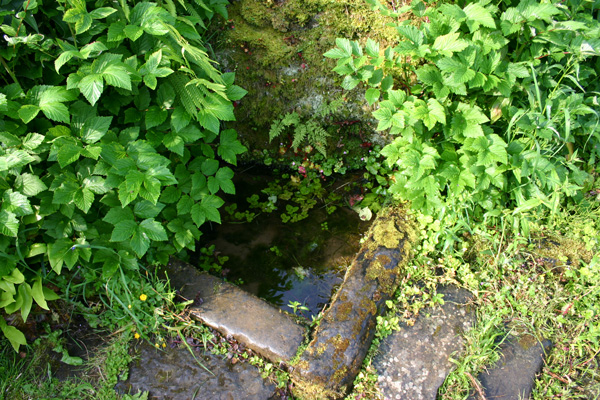
St Mungo's Well (Cumbria) submitted by ocifant on 26th Jun 2005. Looking at the various maps, the location of this well is difficult to discern. It's actually easy to find once you get to the church though.
From St Kentigern's in Caldbeck, walk through the churchyard from the road, and exit via the rear gate. Cross the footpath to the river. Immediately on entering the river path, there are a couple of steps down to the riverbank. These lead to the well.
(View photo, vote or add a comment)
Log Text: St Kentigern's Well, Caldbeck: This was our last stop of the day, and to a part of Cumbria we've never travelled through before. From St. Bridget's in Brigham, we followed the B5299 to Caldbeck village, which took us over cattle grids and moorlands, with only sheep and the occasional other car in sight.
Caldbeck is a really pretty little village, and we resolved to come back during the daytime, when the shops, church and café were open.
The well can be easily found by walking down the footpath to the west of the church, until you get to the bridge over the river. As it says in the "Holy Wells of Cumbria" booklet, turn left just before the bridge, and you immediately come to some steps down the (steep-ish) bank to the river. We heard the trickle of water down the slope, and the well basin comes into view as you look down. At the time of our visit the water missed the basin and was trickling down the rock, under the shrubbery, into the river. There was a fair flow of water coming down the bank.
We walked along the footpath along the northern side of the churchyard for about 100mand found a lovely weir with small waterfalls. It was possible to walk down to the gravel beach. A lovely spot indeed.
Brandy Well (Great Whittingham)
Trip No.92 Entry No.1 Date Added: 21st Aug 2018
Site Type: Holy Well or Sacred Spring
Country: England (Northumberland)
Visited: Yes on 21st Aug 2018. My rating: Condition 3 Ambience 4 Access 4
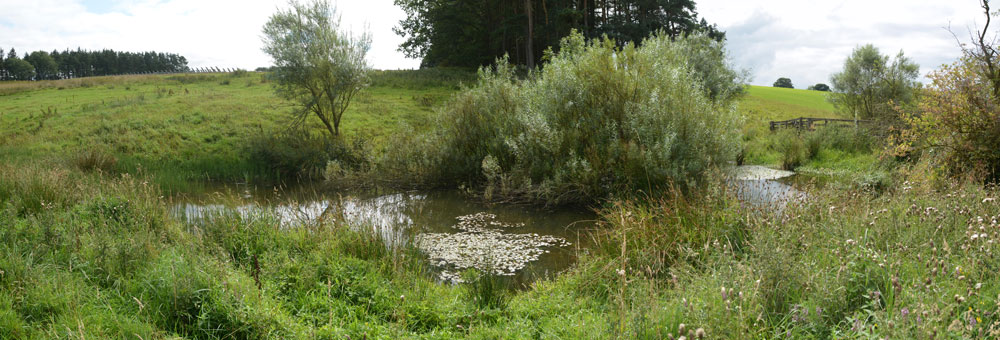
Brandy Well (Great Whittingham) submitted by Anne T on 21st Aug 2018. This panorama of the well pool is taken from just over the wooden footbridge at its north western side. A very peaceful, lovely spot.
(View photo, vote or add a comment)
Log Text: Brandy Well, Todridge Farm, near Great Whittingham: We decided to stop off here on our way to Carlisle to look for this unusually named holy well, near The Queens Arms pub/Chinese restaurant we’ve been to several times. We parked at NY 99652 71590, on the verge before the entrance to Todridge Farm. The farm is more than just a farmhouse and a barn – it’s a hamlet with a number of houses.
Following the track to NY 99143 71795, there is gate into the field on the right hand side (the footpath sign has worn away, it’s just a small white plaque), and we followed this diagonally across the field to the end of the wood, passing a small solar energy ‘farm’ to our right hand side. At about NY 99084 71982 there is a small wooden gate with a footpath sign on it, but this was firmly tied up with a number of ropes (the hinges had broken), so we used the larger gate into the field, and walked a few tens of metres down the slope to the bridge.
On the bridge, you can hear water trickling at the edge of the pool; looking down, there is a dam which lets water out into the stream beyond. Having photographed the well pool from the bridge, we walked up to the land bridge/tractor track at NY 99134 71998 and turned left towards the northern side of the pool. There, in the corner of the fence, we could see the remains of a stone structure, now fallen into what looked like an extension to the pond, where people used to pull water out of.
This is a very pretty spot and a very pretty, if now overgrown, pond, full of waterlilies.
Todley Hill Mound (Great Whittingham)
Trip No.92 Entry No.2 Date Added: 21st Aug 2018
Site Type: Misc. Earthwork
Country: England (Northamptonshire)
Visited: Yes on 21st Aug 2018. My rating: Condition 3 Ambience 4 Access 4
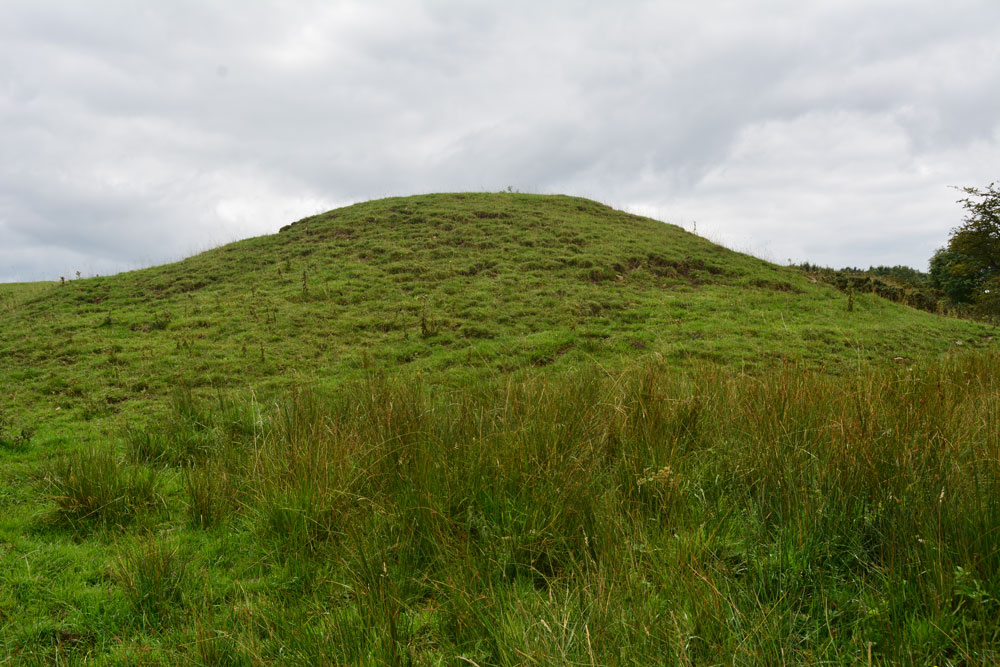
Todley Hill Mound (Great Whittingham) submitted by Anne T on 21st Aug 2018. Standing by the small ford across the stream to the north of the mound, looking south as the mound rises high above us.
(View photo, vote or add a comment)
Log Text: Todley Hill Mound, near Great Whittingham: Walking back to the car, we saw a couple of vans with trailers belonging to the farmers, and I was looking for someone to ask permission to enter the field to see the mound, but whilst the trailer doors were left wide open, no people were visible. There was a gate into the field at NY 99675 71602, almost opposite where we’d parked the car, but there was a stream in the way. We opted to drive further back up the road, and parked at NY 99488 71218, where the road widens out into a large field entrance and dump for roadstone.
The gate into the field had been chained shut, so we walked back down the road and found part of the fence we could hop over.
This is a large mound, in a pretty spot with a small stream to its northern side. There appeared to be a large earth-fast boulder towards its south western side, with smaller boulders surrounding it, but the latter had been broken and were probably field clearance.
Walking round the mound, it appeared to us to have vague traces of a kerb with boulders/stones poking through, mainly on its southern and eastern sides.
This mound/tumulus/barrow is right on the old Roman Road, the Devil’s Causeway, jus to the east of where this cuts the modern road. The vague remains of an edge of this road can be seen (possibly) in the field opposite, to the south of the small stream (or it maybe modern uplift from dredging the stream).
This really had the feel of a barrow to me, and I enjoyed walking round it.
Hawthornside Farm (Bonchester Bridge)
Trip No.93 Entry No.1 Date Added: 31st Aug 2018
Site Type: Holy Well or Sacred Spring
Country: Scotland (Scottish Borders)
Visited: Yes on 29th Aug 2018. My rating: Condition 3 Ambience 3 Access 5
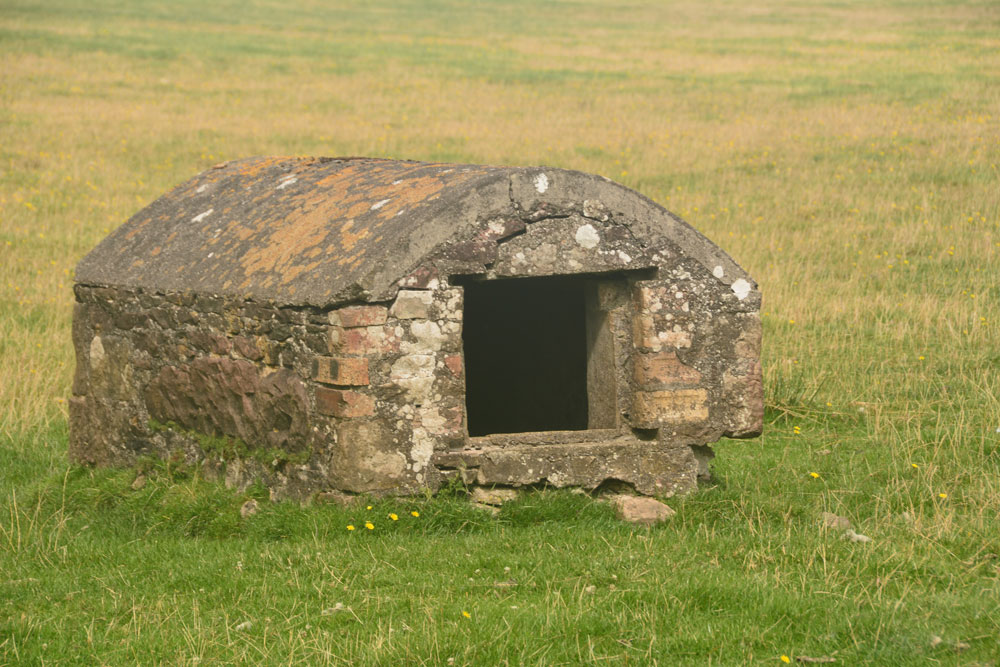
Hawthornside Farm (Bonchester Bridge) submitted by Anne T on 31st Aug 2018. This 'well house' is marked as a tank on the Canmore map, although the structure looks old and the chamber holds clear water. I'd love to know more about this well/tank if anyone has any information. We spotted it by chance trying to find our way to Bedrule.
(View photo, vote or add a comment)
Log Text: Well/tank, Hawthornside Farm (Bonchester Bridge): We spotted this ‘well house’ purely by chance as we passed by, then needing to turn the car round to go to Bedrule Church with its hogback fragments. This is a lovely site, right by the A6088. The well house (or ‘sink’ as it is labelled on the Canmore map) has Rubers Law Hillfort in the background.
There is no mention of Canmore, apart from the word ‘tank’ on its large scale map. The water appears to come straight up into the well basin – there is no sign of a pipe in or out. It does have the hinges for a (presumably wooden) door, which is no longer there. The water was beautifully clear and the inside of the structure clean.
Rubers Law
Trip No.93 Entry No.2 Date Added: 31st Aug 2018
Site Type: Hillfort
Country: Scotland (Scottish Borders)
Visited: Saw from a distance on 29th Aug 2018. My rating: Condition 3 Ambience 4 Access 3
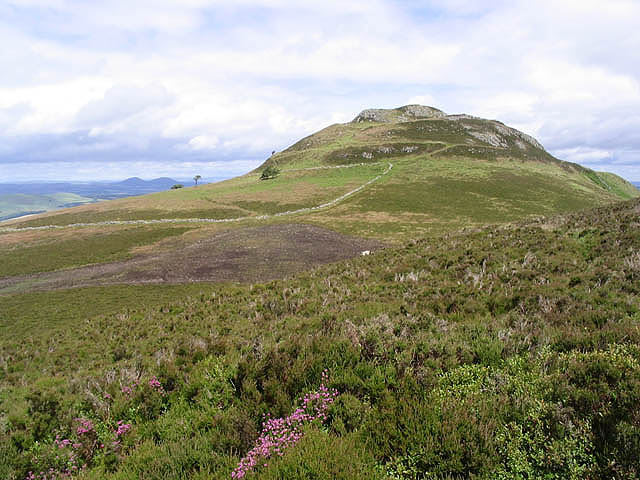
Rubers Law submitted by Creative Commons on 30th Aug 2010. Site in Scottish Borders Scotland
Approaching Rubers Law
Walking through heather near Cloon Craig towards the distinctive summit of Rubers Law with the Eildon Hills on the horizon to the left.
Copyright Walter Baxter and licensed for reuse under the Creative Commons Licence.
http://www.geograph.org.uk/profile/6638
(View photo, vote or add a comment)
Log Text: Rubers Law (only seen from a distance): This impressive hill fort dominates the area. We decided it was too far and too high to attempt today, although I was fascinated by its changing profile as we drove along the minor roads to Bedrule. We will come back when we're feeling fit and strong - it looks like a long walk, gaining height very quickly over a relatively short distance.
I stopped to take photo from the well house (MP 93.1), then at various points along the route:
1. NT 57304 12321
2. NT 59495 15298 By entrance to track signposted to Rubers Law
3. NT 59965 17983 From Bedrule Parish Church
Bedrule Parish Church
Trip No.93 Entry No.3 Date Added: 31st Aug 2018
Site Type: Sculptured Stone
Country: Scotland (Scottish Borders)
Visited: Yes on 29th Aug 2018. My rating: Condition 3 Ambience 4 Access 5

Bedrule Parish Church submitted by Anne T on 31st Aug 2018. A close up of the longer, almost rectangular hogback fragment, described as (2) in the Canmore record: "A fragment of a hog-backed tombstone measuring 1 ft. 3 1/2 in. in length by 7 in. thick, each side being 7 1/2 in. broad and showing three rows of shingle pattern."
(View photo, vote or add a comment)
Log Text: Hogback fragments, Bedrule Parish Church: (note for less mobile visitors, whilst access into the churchyard is on a tarmacked path, there are some steps up into the porch where these fragments are stored. Disabled access is signposted but the door was locked at the time of our visit). This parish church is in the tiny hamlet of Bedrule. We could see the church from the minor road, but had to go virtually through the village and turn south past a row of small cottages to reach the church. There was a small car park outside the churchyard gates. Rubens Law is to the south and dominates the view, which is rather nice.
The western side of the churchyard is divided into a series of ’garden rooms’, each with a small collection of interesting, old grave slabs, some dating to the 1650s.
The hogback fragments were inside the porch, along with a small stone with recumbent, robed figure. The fragments were underneath the small table with prayer and hymn books, so we moved the table out of the way (and replaced it), to photograph the fragments.
Fast Castle (Bedrule)
Trip No.93 Entry No.4 Date Added: 31st Aug 2018
Site Type: Misc. Earthwork
Country: Scotland (Scottish Borders)
Visited: Yes on 29th Aug 2018. My rating: Condition 2 Ambience 4 Access 4
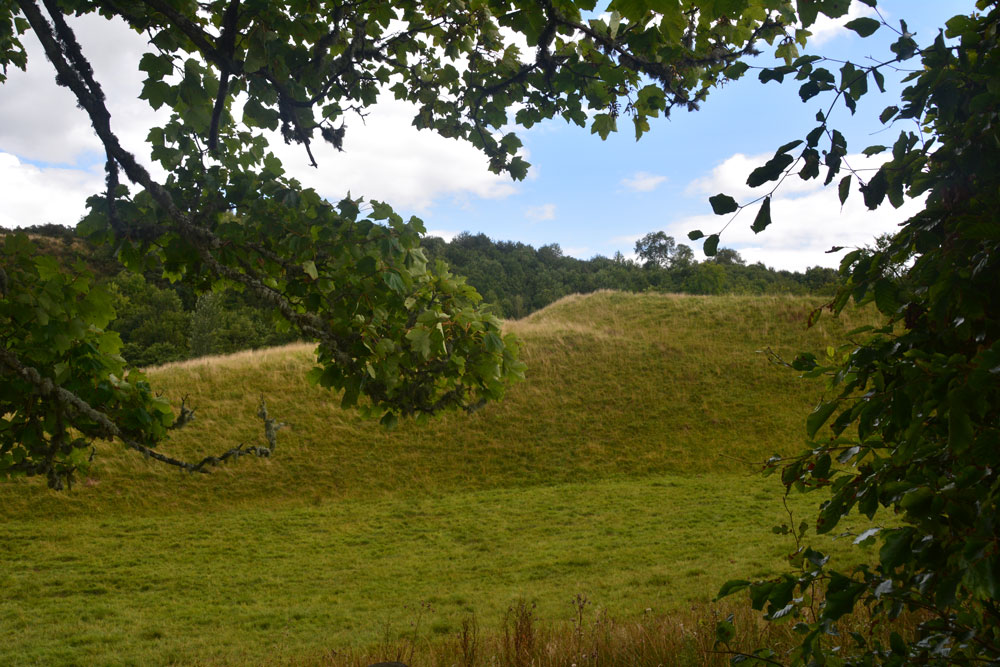
Fast Castle (Bedrule) submitted by Anne T on 31st Aug 2018. Our first view of this large earthwork/motte through the trees from the minor road from Bedrule to the Jedburgh Road.
(View photo, vote or add a comment)
Log Text: Fast Castle/Bedrule Motte: Not far from Bedrule Church this motte is marked on the map. At first it just appeared as a mound behind some trees, and we weren’t going to stop, until we realised the tree cover finished and the motte was clearly visible from the track going to Bedrule Mill. We let ourselves in through the gate and stopped to photograph this impressive mound. It sits by a bend in the very pretty river Rule.
Cavers Cross
Trip No.93 Entry No.5 Date Added: 31st Aug 2018
Site Type: Ancient Cross
Country: Scotland (Scottish Borders)
Visited: Yes on 29th Aug 2018. My rating: Condition 2 Ambience 4 Access 5
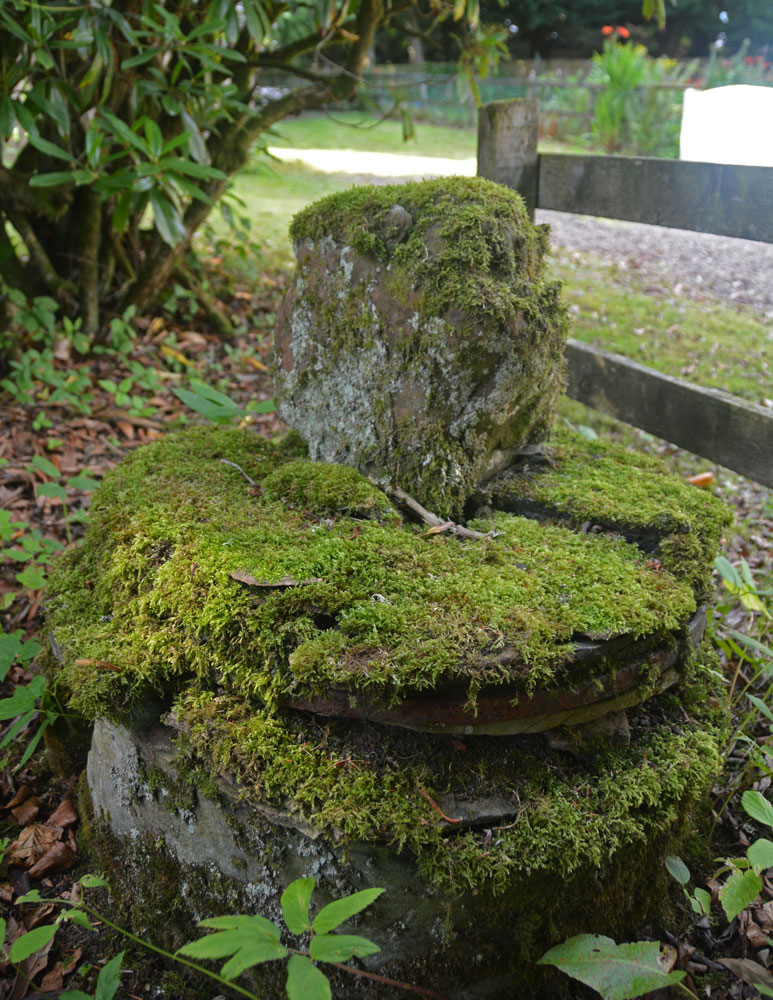
Cavers Cross submitted by Anne T on 31st Aug 2018. A view looking across the cross to the north, towards the small 'cross roads' in the centre of the hamlet of Cavers. The base is round but in pieces which have been stacked on top of each other, held together in places by old metal staples.
(View photo, vote or add a comment)
Log Text: Cavers Cross, near Hawick: From the motte, we drove round to Cavers – a very nicely kept estate, with well kept verges and few places to park along the straight, narrow road by the houses. In the end, we pulled right up to the fence at the largish entrance to a field gate at NT 54235 15805, intending to run back to the car if anyone thought we were in the way.
Walking south west towards the houses (I didn’t even recognise the Auld Kirk, as its been converted into a house with large driveway), we couldn’t see anything resembling a cross. There was a lady who was painting her fence and her large dog, who barked at us and sniffed my hands. I asked her if she knew of the remains of the cross, and she said, “Yes, but it’s only small”. She showed us where it was ‘hiding’ – behind a fence and shrubs in deep shade, then behind its own wooden fence, now much broken. She gave us permission to go into the garden of the holiday cottage as there was no-one there at the time of our visit. Whilst the Canmore record mentions the base of the cross (with the metal bands much visible), nothing is mentioned about the shaft it currently holds. This is of red sandstone and shaped, although much moss-covered.
Moving a small bit of stone near the join of the shaft and the base, there is evidence of a straight cut for part of the socket hole. We didn’t’ see any dowel holes, as the surface was moss and twig covered, but then the report that mentions this is dated 1933!
Midshiels Standing Stone
Trip No.93 Entry No.6 Date Added: 31st Aug 2018
Site Type: Standing Stone (Menhir)
Country: Scotland (Scottish Borders)
Visited: Yes on 29th Aug 2018. My rating: Condition 3 Ambience 4 Access 4

Midshiels Standing Stone submitted by Anne T on 4th Jun 2017. This is the nearest we could get to the standing stone on the evening of our visit. The field was full of quietly grazing sheep but many lively, curious young bullocks. The minute we started to open the gate, they were racing towards us.
(View photo, vote or add a comment)
Log Text: Midshiels Standing Stone, near Hawick: At our last visit, we were put off from entering the field because of a very large bull and his ladies. The bull stood guard near the stone, and any approach made him stand tall, with splayed legs, looking menacingly at us – I contented myself with taking photos from near the gate in the field.
At this visit we parked near the entrance to Midshiels farm, at NT 53459 17603, where we made sure we weren’t blocking the entrance into field. Immediately opposite, at NT 53461 17624 is a metal gate into the field, with the top of the stone just visible.
Husband, Andrew, opened the gate and was in the field, and I was just about to follow when a loud voice behind me stopped me going an further. There was a large, but friendly, farmer and his lad in a very large pickup truck. “There are bullocks in that field – if they see you, they’ll go for you. Drive into the next field and go up to the tunnel – you can turn round there. You can see the stone from there.” I thanked him for the ‘heads up’.
Andrew moved the car, but rather than drive the car up to the tunnel, the ground was a bit too uneven to risk the bottom of the car, so we left it at the edge of the field at NT 53518 17745 and walked to the gate near the tunnel at NT 53388 17830. From here, it looked as if all the cattle were at the far end of the field, with many of them lying down, although the hump in the middle of the field made it difficult to really see. We decided to take the chance and walk to the stone, as we could have got back to the gate quickly.
This stone was glorious in the sunshine, with a most peculiar small ‘hook’ to the top. I tried to capture the shadow in the strong sunshine.
Midshiels Cairn
Trip No.93 Entry No.7 Date Added: 31st Aug 2018
Site Type: Cairn
Country: Scotland (Scottish Borders)
Visited: Yes on 29th Aug 2018. My rating: Condition 3 Ambience 4 Access 4
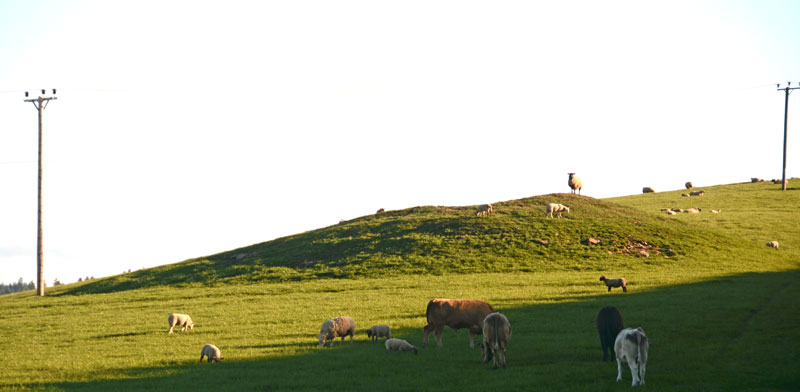
Midshiels Cairn submitted by Anne T on 4th Jun 2017. This is the closest we could get to the cairn on this visit - most of the young bullocks that had been on the right hand slope of the cairn were running (fast!) towards where we were standing at the gate to the field.
(View photo, vote or add a comment)
Log Text: Midshiels Cairn: Having been warned about the large cattle who might "go for us if they saw us", I was cautious about walking the additional 100m from the standing stone to the cairn. Andrew decided that as the cattle were at the far end of the field, and though large, looked relatively docile. “If they come for me I can always leap over the fence (to the railway embankment)”, he said, so I gave him the camera and left to explore the cairn, which seemed much further away than the standing stone, but in reality was only around 90m away.
The Canmore entry of 1948 says the cairn was ‘planted with trees’, although it is now only covered in grass.
Borthwick Mains
Trip No.93 Entry No.8 Date Added: 31st Aug 2018
Site Type: Class I Pictish Symbol Stone
Country: Scotland (Scottish Borders)
Visited: Couldn't find on 29th Aug 2018
Log Text: Borthwick Mains Possible Pictish Symbol Stone: We got the location of this symbol stone completely wrong, and whilst we found Borthwick Mains, did not find the symbol stone. Its now high on my 'wish list' to return to. A lot of building work had been happening here, with the entrance to the farm in the process of being widened, and the house nearest the road empty and almost derelict. I did venture into the garden, but not having any phone signal, did not have the photo of the stone on Canmore to refer to.
Whitcastle Sike
Trip No.93 Entry No.9 Date Added: 31st Aug 2018
Site Type: Ancient Village or Settlement
Country: Scotland (Scottish Borders)
Visited: Yes on 29th Aug 2018. My rating: Condition 2 Ambience 3 Access 4

Whitcastle Sike submitted by Anne T on 31st Aug 2018. This panoramic view is the only way I could capture the form of this settlement, and is a stitch of three photos. Here I'm standing on a small bank which rises out of the tributary of Newmill Burn which runs to the western side of the settlement, forming a pool of water. The land to the north and west is marshy, and it looks as if the land has been built up around these sides to form a raised enclosure. Parts of the settlement have been quarried out. At the left hand side of the hill above is t...
(View photo, vote or add a comment)
Log Text: Whitcastle Sike Settlement: The OS map shows a group of settlements and hillforts which can be found to the east north east of Broxholme Easter Loch, and today in a pretty remote spot down a gated road. We parked at NT 43929 11939, at the wide entrance to a farm track/field entrance and walked to the gate into the field opposite.
On the map, it looked like these settlements would be pretty easy to pick out. Unfortunately, on the ground, the land had been heavily quarried and tall grass and bracken made picking out the land shapes a little tricky. We managed to identify this settlement by its location next to the stream. Whilst it had been heavily quarried, walking around its outline made it easier to identify.
To the west of this settlement is a very pretty burn which trickles past, forming pools in several areas. To the west and north, the ground around the settlement is boggy, but the area of the settlement is a metre or so above the water and dry; it looks as if the edges of the oval enclosure has been deliberately built up to form a protective kerb.
Whitcastle Hill
Trip No.93 Entry No.10 Date Added: 31st Aug 2018
Site Type: Hillfort
Country: Scotland (Scottish Borders)
Visited: Saw from a distance on 29th Aug 2018. My rating: Condition 2 Ambience 4 Access 3
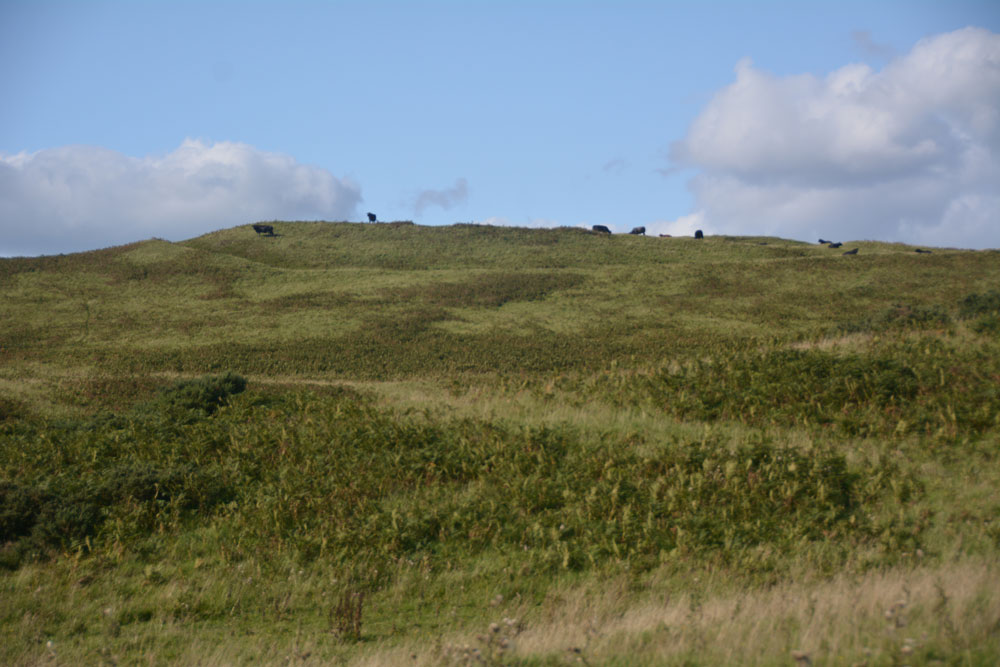
Whitcastle Hill submitted by Anne T on 31st Aug 2018. The groove of the outer defensive bank and ditch of this large prehistoric earthwork/hillfort can be seen at the top of the hill. Having already had one encounter with large cattle earlier in the day, we elected to return another day to take a closer look.
(View photo, vote or add a comment)
Log Text: Whitcastle Hill Prehistoric Earthwork: We decided to return to this site another day, having had a glimpse of the herd of very large cattle grazing over the site. Shame - the aerial photograph of this site on Canmore looks absolutely fascinating!
Whitley Castle (Alston)
Trip No.94 Entry No.1 Date Added: 2nd Sep 2018
Site Type: Hillfort
Country: England (Northumberland)
Visited: Yes on 31st Aug 2018. My rating: Condition 3 Ambience 4 Access 4

Whitley Castle (Alston) submitted by Anne T on 2nd Sep 2018. Standing just to the east of the stone wall dividing the site, at its western end, looking over this remarkable series of ramparts. The fort has 'numbered flower pots' scattered around, which link up with a map, so it's easy to find your way around and interpret this site.
(View photo, vote or add a comment)
Log Text: Whitley Castle / Epiacum Fort/Iron Age Hillfort: We were initially going to Kirkheugh to see the old cross there, but were on the wrong side of the river, and passed the fort, named Whitley Castle on the OS map, so stopped in the car park. There was a van and two other cars in the car park, and we could see people on the hillside above, so thought it must have attracted lots of other visitors.
There are new signs around, along with leaflets under the information board. Now called by its Roman name of Epiacum, the way to the fort is well signposted, and by following the numbered tour (spot the numbered flowerpots) we understood where we were.
As we climbed the hill, one of the men at the top had a stepladder – Postman from the Portal? I asked myself. Another had a ranging pole. By the time we reached the top they were sitting having a cup of coffee before continuing. I asked them if they were doing a survey, and realised I was talking to Stewart Ainsworth of Time Team fame. He, Alastair Robertson and colleague (whose name I didn’t ask but whose face was very familiar) were doing a survey in preparation for taking down a ‘modern’ stone wall to open up the fort site. At the moment, to get access to the Vicus and other parts of the site, you have to walk a long way round through different gates. What a multiple ditch system!
For my future reference: Stewart mentioned a 138 page report produced by English Heritage, which I’ve downloaded to both the picture folder and my Megalithic Portal/Useful Information About Sites folder.
Also see https://www.epiacumheritage.org/
